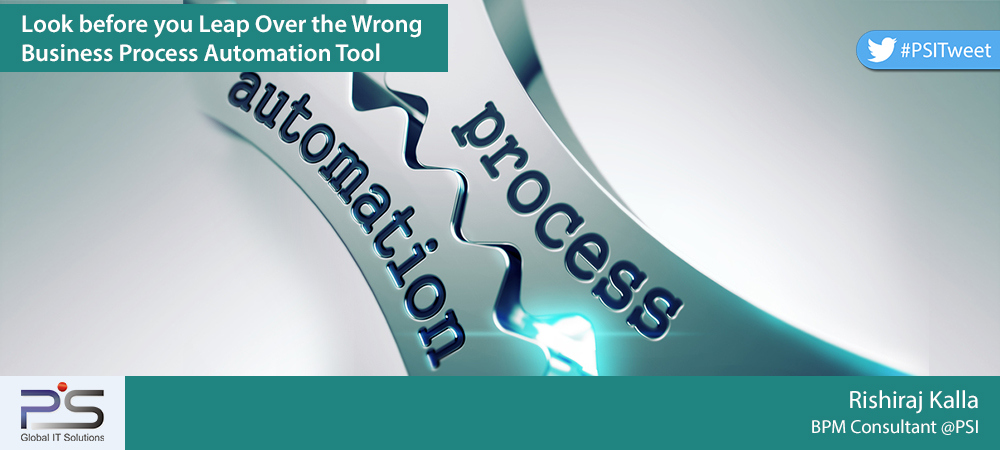Many a times, BPM technology service providers face a dilemma while automating a workflow requirement for a client, they realize the process itself is outdated. The client, on the other hand, wants to resolve the current situation rather than focusing on the overall business processes and operating model. At times, it’s difficult to convince the customer about the existing relevance of the old legacy processes and investments required for resulting inefficiencies.
What is required? An assessment of the existing processes along with the issues and concerns faced at various levels of the processes is required. The comparative gap analysis is conducted to identify and consolidate the pain points in the processes.
A major loophole occurs when the customer has little or no technology involved in its business processes. The client may have no focus and knowledge of the technology requirements, governance necessities, lack of vision in the system and no distinct point of contact. All these lead to prolonged negotiations and loss of business revenue for both the parties.
The technology partner needs to assess the existing system and provide a comprehensive set of recommendations for the technology stack to be used. A BPM solution to automate and improve the process efficiency is the need of the hour.
While exploring the technology stack, the first and foremost question that is being analyzed and worked upon is: which is the right BPM tool/suite/platform to automate the business process (es) of the organization?
Today choices have increased tremendously for licensed BPM tool/suites. At the same time, some outstanding open sources have evolved and are giving a tough competition to the market leaders. Also, there are some pure play BPM vendors and other tools may claim to have capabilities built into the product to automate workflow.
Next, I will discuss the importance of the business application nature and its role in choosing the BPM tool.
Process Discovery and Gap Analysis: Digging Deep
Most of the businesses do not hesitate in communicating the reasons behind the motive of getting business process(es) automated. Generally, it is stated in the initial discussions around process discovery and gap analysis. In my view, I can categorize the business process to be automated, as below:
- Application which have business process (es) as heart and soul of the solution
- Application which have business process (es) as a part (integral) of the solution
To make it clear let me share with you one example of a business application from each category.
A BPO organization approaches an IT team to automate the business process involved in their process of scanning invoices for accounts receivables and reconciling it with ERP or other such systems. This application has integration with ERP system and, other than that, most of the things that any user needs to do can be clearly mapped in the business process. Thus, by enlarge the business process covers all the functions that different types of users need to do in their regular operations and this business process can be said to be the heart and soul of the solution. While I will work on the other details to come up with rationale for selection of BPM tool but at this junction one thing that I know is that I need a BPM tool which:
- Has ability to quickly design, develop and deploy the business process
- Has the ability to host the complete solution and can be easily scaled to meet the growing user base.
- Has excellent integration capabilities with other systems/sub-systems like ERP etc.
- Has inbuilt features that help in meeting the day to day operations for the business solution e.g. collaboration, document viewing etc.
Now let me share with you another business application which is supposed to analyze the product sales during a period and conduct a predictive analysis to suggest the applicable promotional offers for the products. Also certain events like dip in profit margin below a specific figure needs to trigger a workflow which comprises market research process and corrective action plan.
The business process in the above application will be a part of the solution and but necessarily the sole and heart of application. Perhaps, the application will have more features around data aggregation, predictive analysis and projections. Since there is need of automating a workflow and other features may also require a BPM tool, in this case I will look for a BPM tool which:
- Has the ability to design, develop and deploy business process (es).
- Can be integrated easily with the other components of a business application.
- Is light weight and does not have heavy memory requirements.
- Is low cost and does not put burden on the budget.
What can be observed from the above scenario is ‘where a needle is required, sword won’t be a wise choice’. After this first screening there might still be many choices left and to further build a rationale of selection, I will need to list down all other requirements of a business application and prepare a usability matrix for a quick comparison. Below is an example of a usability matrix to figure the utilization of features of BPM tool:

The above matrix is an example to demonstrate that such kind of usability matrix are also helpful in building the rationale for selection and they should be considered to suggest an appropriate BPM tool.
With a little emphasis on figuring out what is the level of business process and where it is placed in overall solution,a usability matrix can be drawn and compared to suggest an organization with appropriate BPM tool.This will not only save money but will also be scalable in long term perspective and prevent organization from moving to other BPM tool and investigating on another problematic area of process and data migration. Image Courtesy: jeffbullas.comMany a times, BPM technology service providers face a dilemma while automating a workflow requirement for a client, they realize the process itself is outdated. The client, on the other hand, wants to resolve the current situation rather than focusing on the overall business processes and operating model. At times, it’s difficult to convince the customer about the existing relevance of the old legacy processes and investments required for resulting inefficiencies.
What is required? An assessment of the existing processes along with the issues and concerns faced at various levels of the processes is required. The comparative gap analysis is conducted to identify and consolidate the pain points in the processes.
A major loophole occurs when the customer has little or no technology involved in its business processes. The client may have no focus and knowledge of the technology requirements, governance necessities, lack of vision in the system and no distinct point of contact. All these lead to prolonged negotiations and loss of business revenue for both the parties.
The technology partner needs to assess the existing system and provide a comprehensive set of recommendations for the technology stack to be used. A BPM solution to automate and improve the process efficiency is the need of the hour.
While exploring the technology stack, the first and foremost question that is being analyzed and worked upon is: which is the right BPM tool/suite/platform to automate the business process (es) of the organization?
Today choices have increased tremendously for licensed BPM tool/suites. At the same time, some outstanding open sources have evolved and are giving a tough competition to the market leaders. Also, there are some pure play BPM vendors and other tools may claim to have capabilities built into the product to automate workflow.
Next, I will discuss the importance of the business application nature and its role in choosing the BPM tool.
Process Discovery and Gap Analysis: Digging Deep
Most of the businesses do not hesitate in communicating the reasons behind the motive of getting business process(es) automated. Generally, it is stated in the initial discussions around process discovery and gap analysis. In my view, I can categorize the business process to be automated, as below:
- Application which have business process (es) as heart and soul of the solution
- Application which have business process (es) as a part (integral) of the solution
To make it clear let me share with you one example of business application from each category.
A BPO organization approaches an IT team to automate the business process involved in their process of scanning invoices for accounts receivables and reconciling it with ERP or other such systems. This application has integration with ERP system and, other than that, most of the things that any user needs to do can be clearly mapped in the business process. Thus, by enlarge the business process covers all the functions that different types of users need to do in their regular operations and this business process can be said to be the heart and soul of the solution. While I will work on the other details to come up with rationale for selection of BPM tool but at this junction one thing that I know is that I need a BPM tool which:
- Has ability to quickly design, develop and deploy the business process
- Has the ability to host the complete solution and can be easily scaled to meet the growing user base.
- Has excellent integration capabilities with other systems/sub-systems like ERP etc.
- Has inbuilt features that help in meeting the day to day operations for the business solution e.g. collaboration, document viewing etc.
Now let me share with you another business application which is supposed to analyze the product sales during a period and conduct a predictive analysis to suggest the applicable promotional offers for the products. Also certain events like dip in profit margin below a specific figure needs to trigger a workflow which comprises market research process and corrective action plan.
The business process in the above application will be a part of the solution and but necessarily the sole and heart of an application. Perhaps, the application will have more features around data aggregation, predictive analysis, and projections. Since there is need of automating a workflow and other features may also require a BPM tool, in this case, I will look for a BPM tool which:
- Has the ability to design, develop and deploy business process (es).
- Can be integrated easily with the other components of a business application.
- Is light weight and does not have heavy memory requirements.
- Is low cost and does not put burden on the budget.
What can be observed from the above scenario is ‘where a needle is required, sword won’t be a wise choice’. After this first screening there might still be many choices left and to further build a rationale of selection, I will need to list down all other requirements of a business application and prepare a usability matrix for a quick comparison. Below is an example of a usability matrix to figure the utilization of features of BPM tool:

The above matrix is an example to demonstrate that such kind of usability matrix are also helpful in building the rationale for selection and they should be considered to suggest an appropriate BPM tool.
With a little emphasis on figuring out what is the level of business process and where it is placed in overall solution, a usability matrix can be drawn and compared to suggest an organization with appropriate BPM tool.This will not only save money but will also be scalable in long-term perspective and prevent the organization from moving to other BPM tool and investigating on another problematic area of process and data migration.
Image Courtesy: jeffbullas.com[:]









